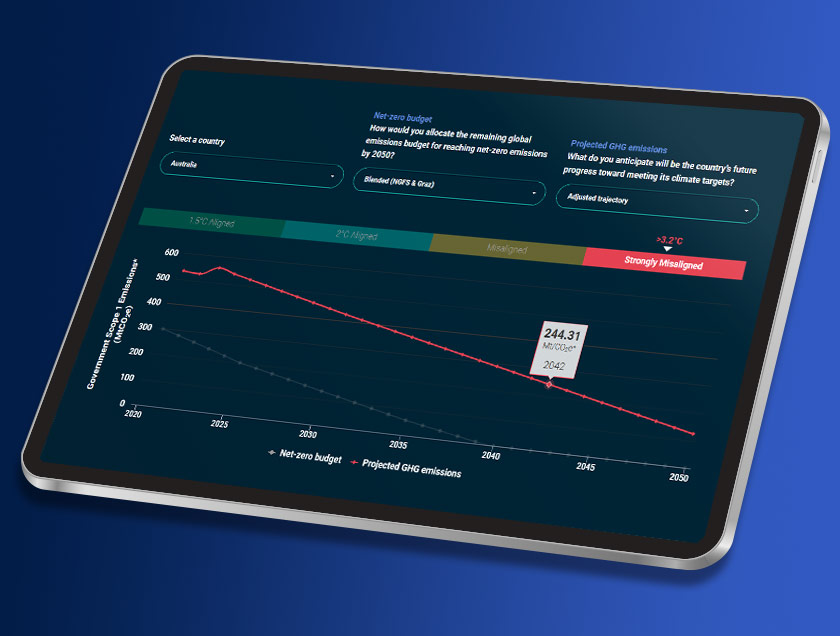The run-up to COP28 saw a cascade of reports on progress by countries and companies to stop climate change that are likely to inform the conversation at the climate summit.
Here are 10 of those reports (including two from the MSCI Sustainability Institute) with the biggest takeaways from each.
Global warming
- Earth is nearly certain to experience its hottest year on record, the European Union’s Copernicus European Earth observation agency reported on Nov. 10.
- “October’s record heat, which marked the fifth consecutive month of record temperatures globally, makes 2023 virtually certain to the warmest year on record, with average global temperatures currently 1.43°C above the preindustrial average,” it notes.
- Concentrations of CO2, methane and nitrous oxide all reached record levels in 2022 and have continued to increase in 2023, the World Meteorological Organization reported on Nov. 15.
- “There is no end in sight to the rising trend,” according to the agency, which reported that average temperatures are on track to rise 2.5°C to 3°C degrees above preindustrial levels.
- Global greenhouse gas emissions would be 2% above 2019 levels by 2030 if current country climate targets were implemented, suggesting emissions will peak this decade but well short of the amount such emissions would need to fall from 2019 levels by 2030 to align with warming of 1.5 degrees, according to a report published on Nov. 14 by the United Nations Framework Convention on Climate Change (UNFCCC).
- “The best estimate of peak temperature in the twenty-first century (projected mostly for 2100 when temperature continues to rise) is in the range of 2.1–2.8 °C depending on the underlying assumptions,” the UNFCCC notes.
- The report follows September’s UNFCCC’ “stocktake” report, which concluded that while climate action is proceeding, much more action is needed now on all fronts to achieve global goals.
- Countries are on track for warming of between 2.5 and 2.9 degrees, depending on whether they fully implement their climate targets, according to the U.N.’s latest emissions gap report, published on Nov. 20. Its top findings:
- Global greenhouse gas emissions in 2022 set a record of nearly 60 Gt (57.4 Gt)
- Current and historical emissions are distributed unequally among countries, “reflecting patterns of inequality.” Per capita emissions in the U.S., for example, are more than double the world average, while those in India remain less than half of it.
- There has been some progress in country commitments since the Paris Agreement was adopted but very little since COP27.
- Further delay in reducing emissions will increase future reliance on carbon removal to meet global climate goals.
- “Life on planet Earth is under siege,” write scientists William J. Ripple, Christopher Wolf and their colleagues in an article published in October, adding that all-time record temperatures this year suggest “we are venturing into uncharted climate territory.” According to the authors:
- Vital signs ranging from Antarctic Sea ice to world surface temperatures are now showing record extremes.
- Carbon emissions have continued soaring; the green recovery that many had hoped for following the pandemic has largely failed to materialize.
- CO2, methane and nitrous oxide – three important greenhouse gases – are now at record levels.
- Ocean acidity, glacier thickness, and Greenland ice mass have all fallen to record levels, whereas sea level rise and ocean heat content are at record highs.
- Forests are increasingly threatened by powerful climate feedback loops involving processes such as insect damage, dieback and wildfire.
- Climate extremes are threatening wider areas that have not typically been prone to such extremes.
Fossil fuels
- The oil and gas industry’s engagement with a clean-energy transition is lacking, the International Energy Agency concludes in a report published on Nov. 23.
- “A moment of truth is coming for the oil and gas industry,” the IEA writes. If governments successfully pursue a 1.5 °C trajectory, and emissions from the global energy sector reach net zero by mid-century, oil and gas use would fall by 75% to 2050.
- The USD 800 billion the industry currently invests each year in the oil and gas sector is double that requred on a pathway to meet declining demand in a 1.5°C scenario
- While clean-energy investment by the oil and gas industry as a whole represented just 2.5% of its total capital spending in 2022 (and 1% of total investment in clean energy), producers looking to align with the aims of the Paris Agreement would need to put 50% of their capital expenditures toward clean energy projects by 2030, on top of the investment required to reduce emissions from their own operations.
- More than 60% of the industry’s clean-energy investment in 2022 came from four companies: Equinor, Total Energies, Shell and BP.
- The energy industry needs to “let go of the illusion that implausibly large amounts of carbon capture are the solution,” the IEA stressed.
- Governments plan to produce roughly 110% more coal, gas and oil in 2030 than would align with limiting global warming to 1.5°C, according to a report published on Nov. 8 by the U.N. Environment Programme.
- The science says that society must phase out global coal production and use by 2040 and reduce oil and gas production and use by three-quarters between 2020 and 2050, the report notes.
- Countries across the Asia-Pacific region could slash nearly three-quarters of their combined carbon emissions, according to an analysis published on Nov. 21 by the MSCI Sustainability Institute.
- Shortening the life of coal plants in 15 APAC markets could help the region reduce CO2 emissions by roughly 160 gigatons (Gt) – 74% below business as usual – with mainland China (116 Gt), India (23.2 Gt) and Indonesia (5.9 Gt) the biggest beneficiaries.
- A managed phaseout would go a long way to align the region’s emissions from coal power generation with the most ambitious global climate targets, but it would not entirely meet the reduction required to keep warming below 1.5°C by the end of the century, according to the analysis, which the Institute prepared at the request of the Glasgow Financial Alliance for Net Zero.
Climate investment
- Listed companies in the world’s largest economies are expected to slow the pace of carbon emissions reductions this decade while decarbonization by their respective home countries is on track to accelerate, the latest MSCI Net-Zero Tracker finds.
- Companies in 13 of 16 G20 nations examined in the report are due to decarbonize by an average of 2.9% annually, a slowdown from 3.2% per year since the Paris Agreement.
- Governments in those countries are likely to reduce national greenhouse gas emissions by an average of 4.5% each year between 2022 and 2030, a faster rate of reduction than the 0.8% average achieved annually after the Paris Agreement.
- Corporate emissions are still peaking: Listed companies are likely to put 12.4 gigatons of GHG emissions into the atmosphere this year, up 11% from 2022, outpacing a 0.3% rise in emissions globally.
- Emissions from listed companies are on track to warm the planet 2.5°C above preindustrial levels; companies’ current trajectory puts them on track to push average global temperatures past 1.5°C above preindustrial levels by April 2026, three months sooner than reported in July.
- Global private climate finance (trillion USD/year) and the ratio of investment in low carbon to fossil fuel energy supply are both heading in the right direction but well off track, according to a report published on Nov. 14 by Systems Change Lab.
- The share of electric vehicles in passenger car sales is the only one of 42 climate indicators assessed that is on track to meet its 2030 target, according to the report, which is published by a collaborative initiative convened by World Resources Institute and the Bezos Earth Fund.


